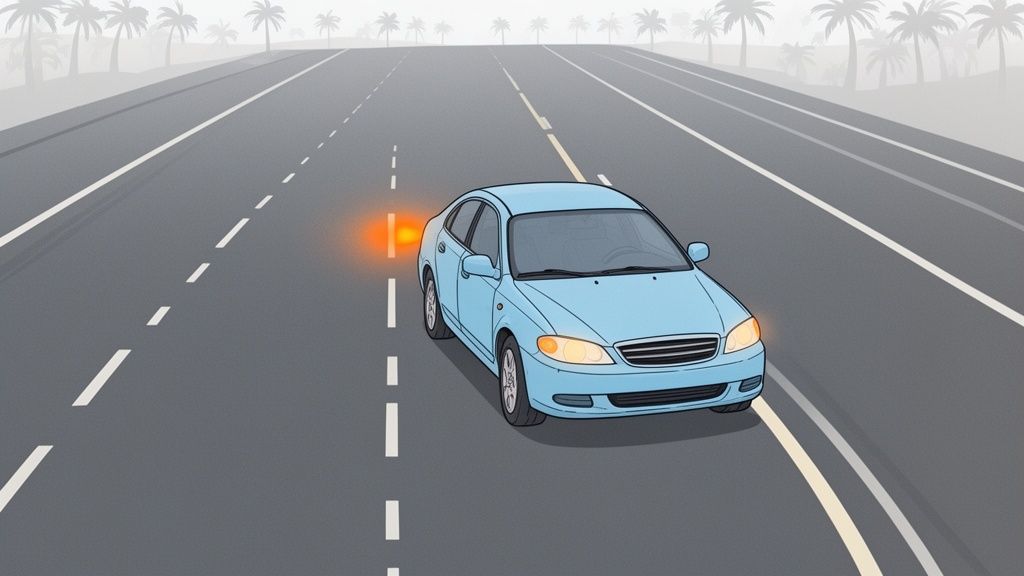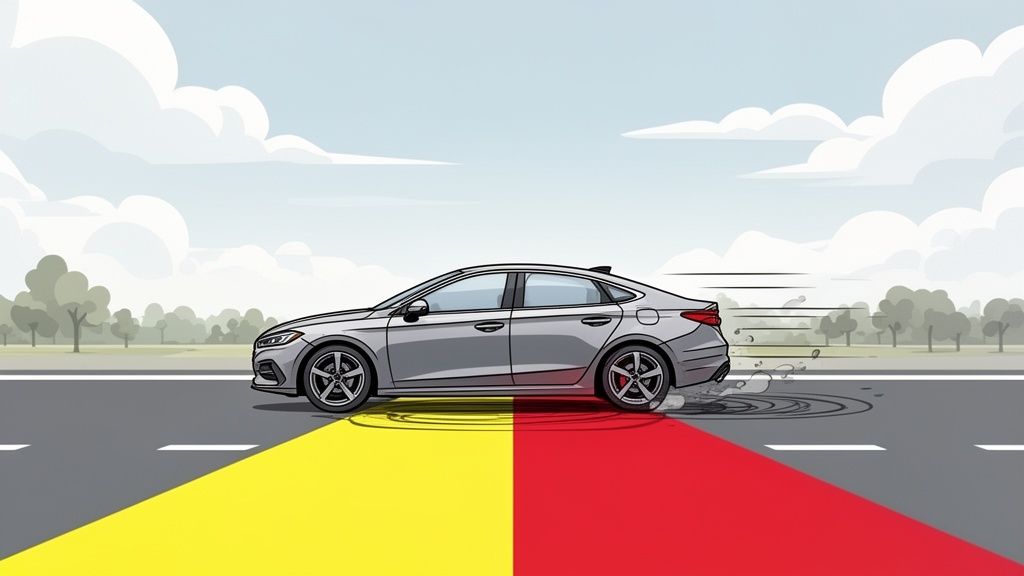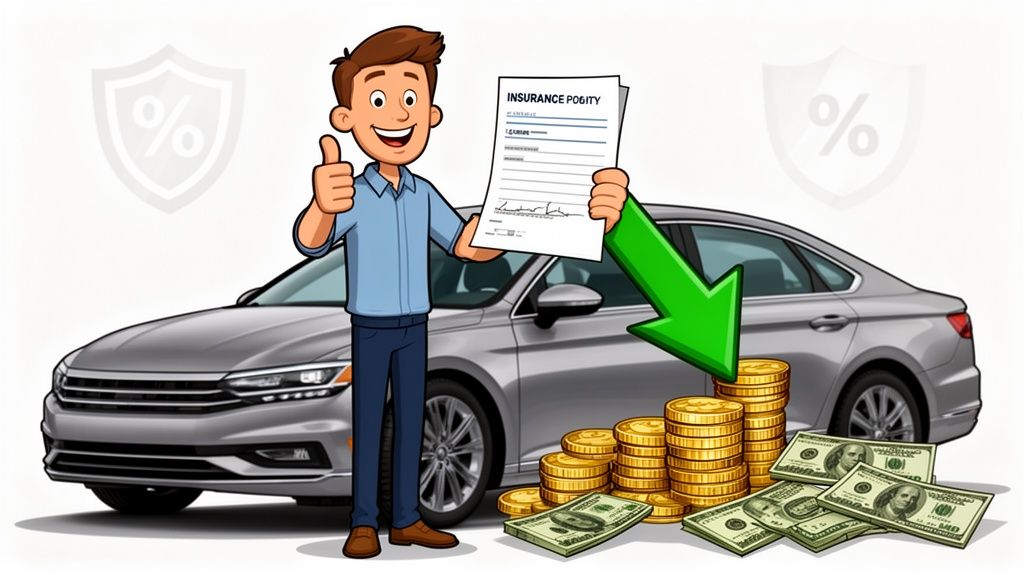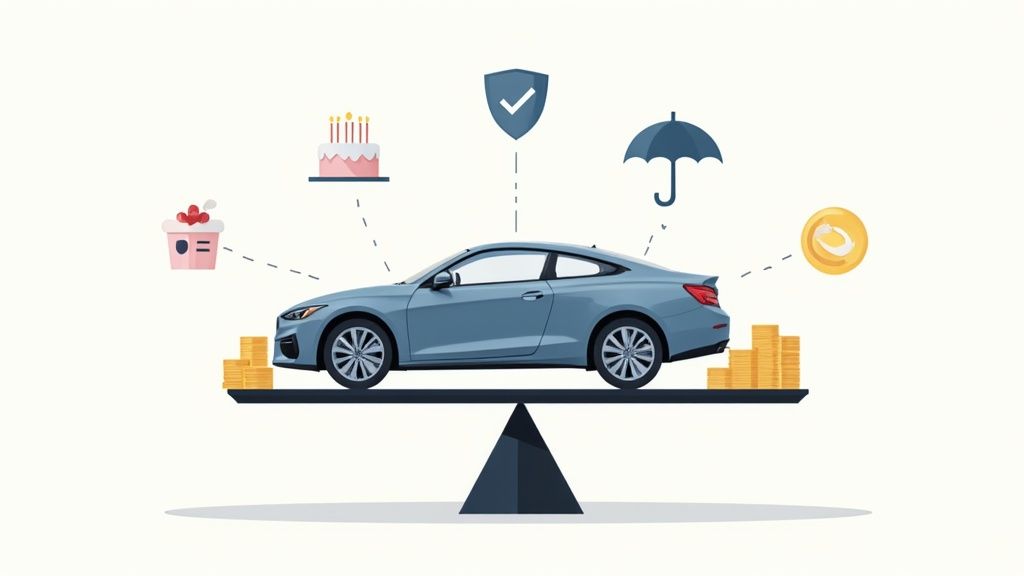When you get behind the wheel, you agree to follow a set of rules. A moving violation is any traffic law you break while your car is in motion. This includes things like speeding, running a stop sign, or making an unsafe turn.
These offenses are more serious than other tickets. This is because they happen while you are actively driving. As a result, they create a much higher risk of a traffic collision. Understanding what a moving violation is can help you be a safer driver.
Defining a Moving Violation
Think of traffic as a team sport. For everyone to get to their destination safely, each driver must follow the same rules. A moving violation is like a player breaking a critical rule during the game. It creates immediate danger and can easily lead to a collision.
That is why law enforcement takes these offenses seriously. Actions like failing to yield or changing lanes without looking are direct causes of crashes and injuries. This is the main difference between a moving violation and a non-moving violation.
Moving vs. Non-Moving Violations
So, what separates the two? It is all about whether the car is being driven. A non-moving violation is an offense related to your vehicle while it is parked. These usually involve the car’s equipment or where you parked it.
Common examples of non-moving violations include:
- An expired license plate tag
- A broken headlight or taillight
- Parking in a no-parking zone
- An expired parking meter
You still need to handle these tickets. However, they do not pose the same immediate threat to public safety. You get a parking ticket when your car is still. In contrast, you get a speeding ticket because your actions created a dangerous situation on the road.
To make it even clearer, here is a quick breakdown of the main differences.

Moving vs. Non-Moving Violations at a Glance
| Violation Type | When It Occurs | Common Examples | Typical Consequences |
|---|---|---|---|
| Moving Violation | While the vehicle is in motion | Speeding, running a red light, DUI, reckless driving, failure to yield | Fines, points on your license, insurance increases, potential license suspension |
| Non-Moving Violation | While the vehicle is stationary or parked | Expired registration, broken taillight, illegal parking, expired parking meter | Fines, “fix-it” tickets, potential for vehicle to be towed |
This table shows why the consequences are so much tougher for moving violations. For example, you face heavy fines, points on your license, and higher insurance rates. Extensive research into traffic offenses shows the focus is on preventing actions that lead to crashes.
Moving Violation: A traffic offense committed by a driver while the vehicle is in motion. Examples include speeding, failure to yield, running a red light, and improper lane changes. These violations are distinguished from non-moving violations, which occur when a vehicle is stopped or parked, such as parking infractions or vehicle equipment violations.
Understanding this difference is the first step. It helps you see why states have point systems and how you can protect your driving record.
The Most Common Moving Violations and Their Dangers
Some driving mistakes are more common than others. These everyday moving violations are a big reason for roadway collisions. First, you should learn what they are and why they are so dangerous. This will help you become a safer, smarter driver.
Remember, roadway laws exist to keep everyone safe. When a driver ignores a rule, the risk increases for everyone nearby. This includes other cars, cyclists, and pedestrians. Let’s look at some of the most frequent offenses.
Speed Management: More Than Just a Number
Driving over the speed limit is the most common moving violation. Many drivers think going five or ten miles over is harmless. However, speed is a huge factor in how often crashes happen and how severe they are. The U.S. Department of Transportation offers data on how speed management saves lives.
It comes down to basic physics. The faster you go, the longer it takes to stop. Higher speeds also mean a more violent impact in a collision. Consequently, injuries become much more severe. This is why fines are higher the faster you go, especially in school or work zones.
According to the National Highway Traffic Safety Administration (NHTSA), speeding was a factor in 29% of all traffic fatalities in 2021. That means more than 12,000 lives were lost because drivers were going too fast.
This statistic shows why speed limits are so important. Obeying them is a simple way to protect yourself and others.
Following Distance and Aggressive Driving
Besides speeding, other behaviors cause serious moving violations. Maintaining a safe following distance is critical for avoiding rear-end collisions.
- Safe Following Distance: A good rule is the “three-second rule.” First, pick a fixed object on the road ahead, like a sign. When the car in front of you passes it, start counting. If you reach the object before you count to three, you are following too closely.
- Aggressive Driving: This includes many dangerous actions. For instance, tailgating, weaving through traffic, and cutting people off are all aggressive. It often starts with impatience and can lead to road rage or a serious traffic incident.
These are not just bad habits; they are illegal and dangerous choices. You can find more official information on risky driving behaviors from the NHTSA. Every moving violation starts with a choice. For example, a driver chooses to speed, tailgate, or drive aggressively. These decisions create unnecessary risks.
How a Ticket Impacts Your License and Finances
Getting a ticket for a moving violation is never fun. The impact often lasts longer than just paying the fine. These citations can affect your driving privileges and your bank account. States use a point system to track your driving habits, and every ticket adds to your total.
Different violations have different point values. The more dangerous the action, the more points you get.

The Driver’s License Point System Explained
When you receive a ticket, your state’s Department of Motor Vehicles (DMV) adds points to your driving record. The number of points depends on the seriousness of the offense. For instance, a minor speeding ticket might be only a few points. However, a major violation like reckless driving could add many points quickly.
If you get too many points in a short time, you face serious consequences. These can include a mandatory driver safety course or even a license suspension.
This image shows how violations are often categorized by severity.
As you can see, worse violations lead to more points and tougher penalties. Here is a look at some common violations and their possible point values.
Example Point Values for Common Moving Violations
| Moving Violation | Typical Point Range |
|---|---|
| Speeding (1-15 mph over limit) | 2-3 points |
| Running a Red Light or Stop Sign | 3-4 points |
| Improper Passing | 3-4 points |
| Reckless Driving | 4-6 points |
| Leaving the Scene of an Accident | 6+ points |
These values are just examples and can vary by state. They show how quickly points can add up on your record.
The Hit to Your Wallet: Insurance Rate Hikes
In addition to risking your license, moving violations almost always cost you money. When you get a ticket, your auto insurance provider sees you as a riskier driver. To them, a violation on your record means you are more likely to be in a future collision.
To cover that added risk, they will likely raise your insurance premiums. This rate hike can last for several years. It could cost you hundreds or even thousands of extra dollars. Even one ticket for excessive speeding can make you seem like a much bigger liability.
A ticket on your record tells insurance companies you’re a higher risk. This often leads to higher insurance costs that can follow you for three to five years.
Keeping your driving record clean is one of the best ways to keep your insurance costs down. If you have already received a ticket, it is important to know your options. You can learn more about how to remove points from your driving record and protect your license and your wallet.
A Spotlight on California Driving Laws
Traffic laws are not the same in every state. While the basics of safe driving are universal, each state has its own specific rules. We will now focus on California to show how it handles moving violations, its point system, and key laws you must know.
Learning these local rules is the best way to stay safe and keep your driving record clean. Knowing what is expected of you is your best defense against a ticket.
California’s NOTS Point System in Action
California uses the Negligent Operator Treatment System (NOTS) to track driving offenses. When you are convicted of a moving violation, the California Department of Motor Vehicles (DMV) adds points to your record. The number of points depends on the violation.
For example, a speeding ticket might get you one point. A more serious offense, like reckless driving or a DUI, will result in two points.
The trouble begins when these points add up. According to the official California DMV website, you are considered a negligent operator if you accumulate:
- 4 points in 12 months
- 6 points in 24 months
- 8 points in 36 months
Reaching these levels will result in a license suspension. The system is designed to identify risky driving behaviors before they cause a major incident.
The California “Move Over, Slow Down” Law
Every driver in California needs to know the “Move Over, Slow Down” law. This law is about creating a safe space for emergency responders and other workers stopped on the roadside. The law has been updated to include more vehicles.
As of January 1, 2021, and updated since, the law requires drivers to move over a lane for any stationary emergency, tow, or Caltrans vehicle displaying flashing amber warning lights. If you cannot move over safely, you must slow to a reasonable and prudent speed. This simple action provides a critical safety buffer for people working on our roads. Full details can be found on the California Highway Patrol (CHP) website.
Your Next Steps After Getting a Traffic Ticket
Seeing flashing lights in your rearview mirror is stressful. A traffic ticket can seem like a big problem, but you have choices. Understanding these choices is key to making the best decision for your situation.
First, take a breath and read the ticket carefully. Note the violation, the fine, and any deadlines. Most importantly, do not ignore it. Ignoring a ticket can lead to a suspended license and even bigger fines.
You have three main paths to take. Your choice will depend on the ticket, your driving history, and what you are willing to do.
Evaluating Your Main Options
Once you understand the citation, you must decide how to respond. Each choice has real consequences for your finances and your driving record.
Let’s break down your standard options:
- Pay the Fine: This is the easiest path. You pay the amount, and the ticket is resolved. However, paying the fine is an admission of guilt. This means you will almost certainly get points on your driving record.
- Contest the Ticket in Court: If you believe you did nothing wrong, you can plead not guilty. This means going to traffic court to present your case. This can take time and does not guarantee you will win.
- Elect to Attend a Driver Improvement Course: For many, this is the smartest option. In many states, you can choose to complete an approved defensive driving course. If you finish it successfully, you can often keep the points off your license.
Making an Informed Decision
Choosing what to do is important. Simply paying the fine is fast, but it can lead to higher insurance premiums later. Fighting the ticket in court is a gamble. You could win, but you could also end up paying the fine and court costs.
For many drivers, taking a driver improvement course is the best choice. It takes a little time, but it offers a guaranteed way to protect your driving record. Before you decide, it is wise to explore all your traffic ticket options to see what makes the most sense for you.
Protecting Your Record with a Driver Improvement Course
Getting a ticket does not have to ruin your driving record. Instead of just paying the fine and accepting the points, you have a better option. A driver improvement course can act like a reset button for a minor violation.
It is a tool that helps you become a safer driver while keeping your record clean. By completing an approved course, you can often prevent points from being added to your license. This is a huge benefit. It helps keep your insurance rates from increasing and protects you from a potential license suspension.
What You’ll Actually Learn in a Course
This is not just another boring class. A good driver improvement course is a useful refresher on important driving skills. The goal is to reinforce good habits and review traffic laws you may have forgotten.
You will learn about practical topics that make a real difference, including:
- Defensive Driving Techniques: This is about anticipating trouble before it happens. You will learn strategies for spotting hazards, reacting safely to other drivers, and maintaining a safe following distance.
- State Traffic Law Updates: Driving regulations can change. The course ensures you are current on the latest roadway laws.
- Collision Avoidance Skills: The curriculum focuses on giving you the skills to see dangerous situations developing. Then, you will know how to avoid them before they lead to a crash.
Investing a few hours in a driver improvement course is an investment in your safety and your financial future. It is a very effective way to handle a moving violation.
For most drivers, taking a driver improvement course in Florida online is the easiest way to deal with a ticket. It offers the flexibility to protect your record from the comfort of your home.
Got Questions About Moving Violations? We’ve Got Answers.
When you see flashing lights, many questions might come to mind. Let’s clear up some of the most common ones about tickets, points, and what happens next.
Do defensive driving classes remove points?
This varies by state. In many states, completing a defensive driving class can prevent points from being added to your record for a specific ticket. However, it usually does not remove points that are already there. You should always check your state’s specific rules on its official DMV or DOT website.
How do points affect insurance?
Insurance companies see points on your driving record as a sign of risk. A driver with points is more likely to be in a future collision. As a result, insurers often raise rates for drivers with recent moving violations. A clean record is one of the best ways to keep your insurance costs low.
How can I find my state’s official driving rules?
The best source is your state’s Department of Motor Vehicles (DMV) or Department of Transportation (DOT) website. These .gov sites have the official driver’s handbook, which contains all the current rules of the road for your state.
What should I do after a minor collision?
First, check if anyone is injured and call 911 if needed. Then, move your vehicles out of traffic if it is safe to do so. Exchange information with the other driver, including names, contact info, and insurance details. Finally, report the incident to law enforcement and your insurance company.
Is there a difference between a “citation” and a “ticket”?
No, there is no difference. Law enforcement and courts use the terms traffic citation and traffic ticket to mean the same thing. Both are official notices that you have been accused of breaking a traffic law.
Ready to take control, protect your driving record, and sharpen your skills behind the wheel? BDISchool has the state-approved online course that lets you handle your ticket and keep those points away.





